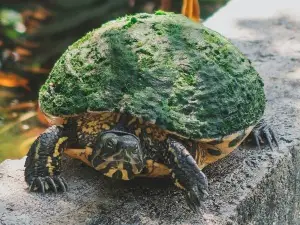
Some animals are naturally fuzzy, they look like this from birth, other animals naturally have scaley skin like turtles, if your turtle, who naturally has scaley skin, starts looking fuzzy you’d understandably be quite confused and concerned
This article looks into why this happens
Table of Contents
Why does my turtle look fuzzy?
Discovering fuzz on your turtle’s skin can be quite perplexing, and this is understandable. These animals are known for sleek smooth skin so any changes in texture will worry you
Here is why your turtle’s skin may look fuzzy
Algae growth:
One of the reasons why your turtle looks fuzzy is because the animal has algae growth.
Algae grows in water where there is an abundance of minerals and light and one of the places that it may grow is on the animal’s shell.
Wild-caught turtles have a higher chance of developing algae growths but turtles from the breeders can develop algae growths too.
What to do:
The turtle won’t be able to remove the algae on its own, what you can do is remove it quite easily using a soft toothbrush
Use a soft new toothbrush and some turtle-safe soap on the animal’s shell to remove the algae. Doing this on a regular basis will also help to prevent the growth from getting out of control.
As long as your turtle’s behavior is normal, as long as the animal isn’t acting ill or distressed, then the animal should be fine.
Using a water conditioner in the animal’s water will also help to keep the algae under control
Fungal infection:
If your pet has fuzziness on its skin then this may be happening because the animal has fungal infection.
Poor or unsanitary conditions cause fungal infections in turtles. If your pet’s water bath, plates, or feeding bowls are left stagnant then bacteria can develop which can cause a fungal infection.
Fungal infections take a while to develop, and they start to be visible long before they start to be damaging, but treating the condition as soon as possible is a must, If this condition is not treated then it can turn into an abscess or spread to your pets bonetissue
Other signs of this condition in your pet, in addition to the fuzziness on the skin, is a rotting or unpleasant smell on your pet, shell plates that fall off, and discharge coming off of the animal’s skin.
What to do:
If you can, taking your pet to the vet is recommended. The vet will be able to offer specialized help to your pet and do any procedures that the animal may need.
If you want to treat your pet at home you can, treating will involve cleaning the animal’s tank and then removing the fungus.
You would remove the fungus by washing the turtle, wash and scrub the fungus with a solution made out of water and a bit of hypoallergenic reptile-safe soap.
Once done, wipe your pet down with a diluted iodine solution
You can alternatively give your pet a salt bath in a bath made up of a gallon of tepid water and 2 to 3 tablespoons of salt. Leat your pet soak in this solution for 20 to 30 minutes.
If you enjoyed this article then you may also be interested in other turtle/tortoise related articles. Here are some articles that you may be interested in: Why Is My Turtle’s Tank Water Red?, Why Does My Turtle Run From Me, Why Is My Turtle’s Shell Turning Yellow?, Why Is My Yellow Belly Turtle Not Eating?, Why Is My Turtle In Its Shell?, Why Is My Turtle Standing Up?, Why Is My Turtle Poop White?, Why Is My Turtle Poop Red?, Why Is My Turtle Underwater?

